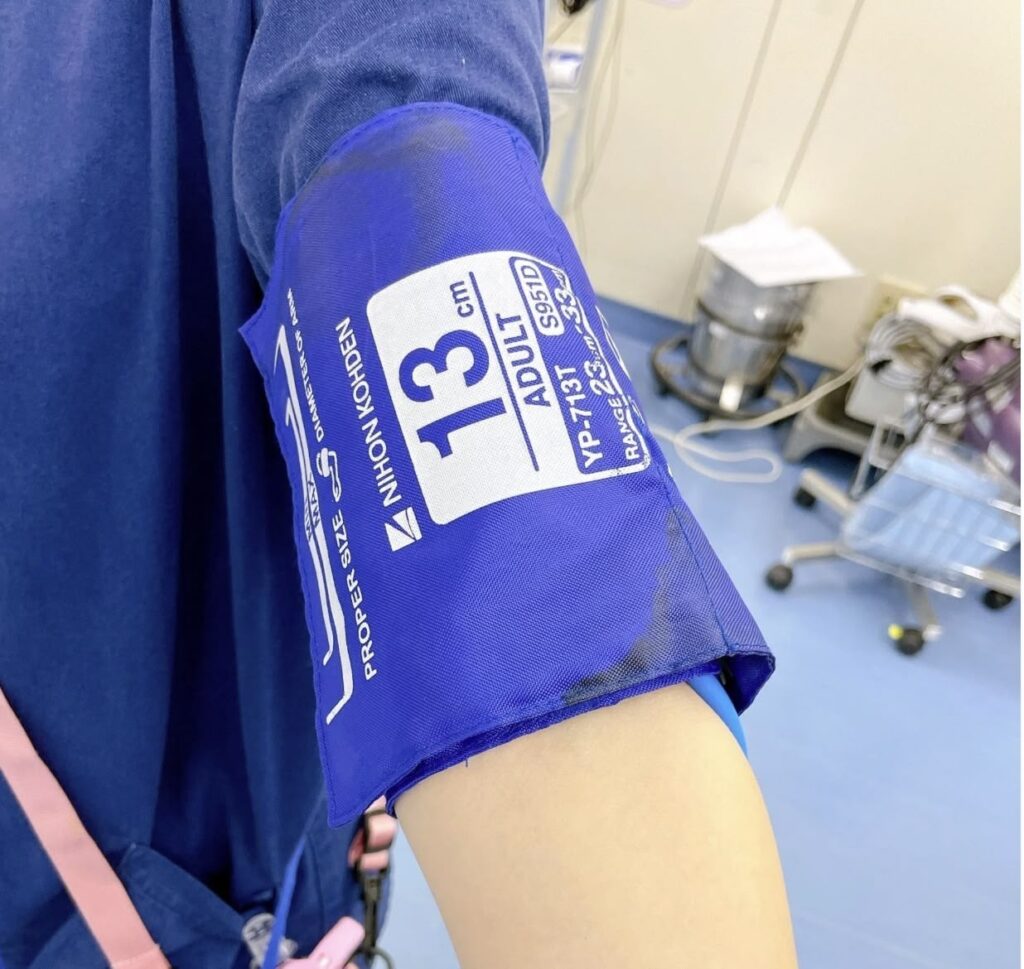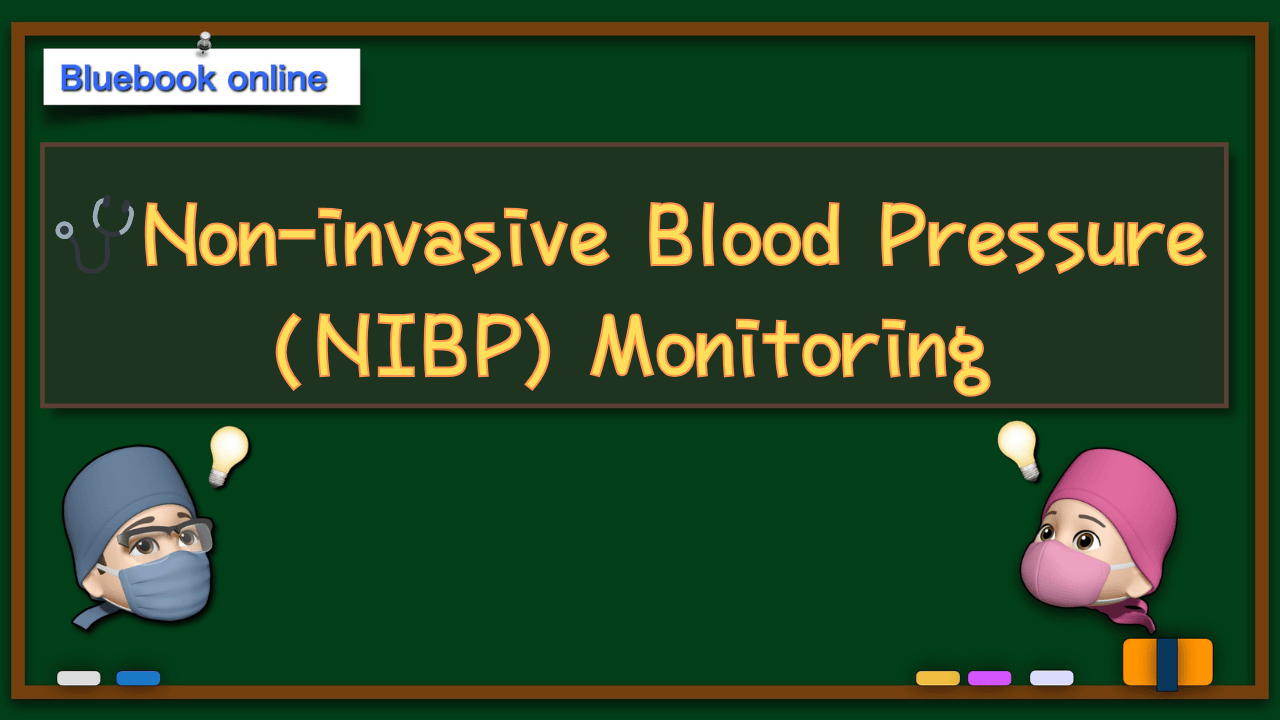👉👉 🇺🇸 All Posts 🇬🇧 / 🇯🇵 記事一覧 🇯🇵 👈👈
♦️ Introduction
When you hear the term circulatory monitoring, the first things that probably come to mind are the following two:
- Blood pressure (non-invasive and invasive)
- Electrocardiogram (ECG)
☝️ These days, blood pressure devices can be found almost everywhere in Japan.

☝️ A standard 13-cm cuff (author’s photo).
Hypertension, together with diabetes, is considered one of the major risk factors for many diseases. Blood pressure measurement is less invasive and easier to perform than glucose monitoring, and nowadays you can see BP monitors not only at home, in outpatient clinics, on hospital wards, and in operating rooms, but also in rest areas of many shops.
In this article, I will briefly explain the basics of non-invasive blood pressure measurement (NIBP). Invasive arterial pressure monitoring—so-called “A-line”—will be covered in another article.
In examinations such as the Perioperative Management Team exam or the Anesthesiology Board exam, questions usually focus on factors that influence measurement accuracy.
♦️ Blood Pressure Measurement: Then and Now
Back in the day (perhaps when today’s 50- to 60-year-old anesthesiologists were still trainees), automatic BP monitors hardly existed. Anesthesiologists had to place a stethoscope under the cuff and inflate/deflate it manually every few minutes. Hard to imagine nowadays… 😱
Of course, at that time there were no digital automated anesthesia record systems. (There were mechanical recorders with a pencil moving automatically… have you ever seen one? 😅) Everything was handwritten. Life was tough for anesthesiologists back then!😅 (I belong to the generation who heard those stories from my seniors 🤗. In my early years, I also wrote anesthesia records by hand ✏️).
Telling these anecdotes is fine, but if you emphasize them too much, people may jokingly call you “old-timer” or “nostalgic boomer.” I sometimes catch myself drifting into such stories, so I try to be careful 😅.
♦️ Measurement Methods
🔷 Auscultatory method (Korotkoff method)
As mentioned above, the traditional method where anesthesiologists or nurses inflate the cuff and listen with a stethoscope is called the auscultatory method or Korotkoff method.
The cuff is inflated to occlude blood flow, then slowly deflated. The reappearance of flow is detected by the Korotkoff sounds.
- The pressure at which the sound first appears = systolic BP
- The pressure at which the sound disappears = diastolic BP
However, accuracy depends on the examiner. Inexperienced users or those who deflate too quickly tend to record falsely low systolic values (because they miss the sound). Environmental noise also interferes.
Nowadays, mercury sphygmomanometers are no longer used (production/import/export banned since 2021 in Japan). Aneroid or electronic devices are the standard.
🔷 Oscillometric method
This is the method used in most automatic BP monitors. The steps are similar to the auscultatory method—inflate the cuff to stop flow, then gradually deflate.
The device detects oscillations in the arterial wall (pressure pulse waves) and calculates BP:
- Point where oscillations first increase → Systolic BP (estimated)
- Point of maximum oscillations → Mean BP (most reliable)
- Point where oscillations rapidly decrease → Diastolic BP (estimated)
Thus, mean arterial pressure (MAP) is quite reliable, while systolic/diastolic values are calculated using algorithms that differ by manufacturer. In the past, sensor performance was poor and results less reliable, but with current technology, differences compared with the auscultatory method are minimal.
Another advantage is that measurement is possible at any site where a cuff can be applied and arterial pulsation can be detected.
♦️ Proper Cuff Size and Application
The width of the cuff should be about 1.2–1.5 times the diameter of the limb (or roughly 40% of the arm circumference).
Tightness: insert 1–2 fingers between cuff and arm (a practical but somewhat vague rule).
☝️ Remember these numbers! If inappropriate, measurement errors occur:
🔷 Cuff width
- Too narrow → falsely high BP
- Too wide → falsely low BP
For adults with average body habitus, a 13-cm cuff is standard. For small adults or children, 10 cm, 7 cm, or 5 cm cuffs are used.
🔷 Cuff tightness
- Too loose → falsely high BP
- Too tight → falsely low BP
If loose, the inflatable bladder expands outward instead of compressing the artery effectively, requiring more inflation pressure and yielding an artificially high value.
Obese patients with “wine-glass-shaped” arms can be particularly challenging 😅.
🔷 Arm position relative to the heart
- 10 cm height difference ≈ 7.4 mmHg pressure difference
- If the arm is below the heart → BP appears higher
- If the arm is above the heart → BP appears lower
- Principle: keep the cuff at the level of the right atrium.
♦️ Other Important Points
- The difference between systolic and diastolic BP is called pulse pressure (to be discussed separately).
- Measurement interval: at least every 5 minutes (ASA monitoring standards). Too frequent measurements may cause peripheral nerve injury.
- Do NOT measure on the arm with an AV fistula (dialysis), lymphedema, or IV line—risk of complications.
📝 Take Home Messages
- NIBP methods: Auscultatory (Korotkoff) and Oscillometric
- Oscillometric: MAP is reliable; systolic/diastolic are estimated
- Proper cuff width ≈ 40% of arm circumference. Narrow → high; wide → low
- Loose cuff → high; tight cuff → low
- Arm height relative to the heart significantly affects results
- Measure at least every 5 minutes (ASA standard)
- Avoid measuring on AV fistula, lymphedema, or IV line side
🔗 Related articles
📚 References & Links
- American Society of Anesthesiologists (ASA). Standards for Basic Anesthetic Monitoring. (2020 update) – Defines the minimum monitoring standard. States that NIBP should be measured at least every 5 minutes.
- Japanese Society of Anesthesiologists. Monitoring Standards for Safe Anesthesia (2020 revision). – Japanese counterpart to ASA standards. Frequently cited in Perioperative Team and Board exams.
- Miller’s Anesthesia, 9th Edition. Chapter on Monitoring. – Comprehensive explanation of measurement principles and accuracy comparisons with invasive monitoring.
- Barash PG, Cullen BF, Stoelting RK. Clinical Anesthesia, 9th Edition. – Clear clinical guidance on cuff size, application, and error factors.
- Morgan & Mikhail’s Clinical Anesthesiology, 7th Edition. – Good summary for trainees; emphasizes “narrow cuff = high, wide cuff = low” concept.
- Pickering TG, et al. Recommendations for Blood Pressure Measurement in Humans and Experimental Animals. Hypertension. 2005;45:142–161. – Classic guideline on BP measurement accuracy; detailed on oscillometric methods.

コメントを投稿するにはログインしてください。